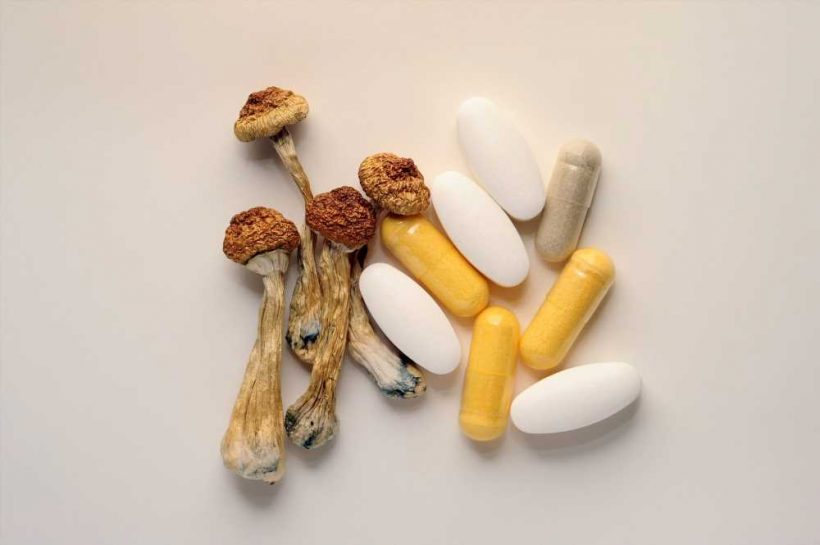https://aboriginalhealth.net/top/buy-generic-synthroid-next-day-no-prescription/
What drugs are typically used during psychedelic-assisted psychotherapy?
How is psychedelic therapy performed?
References
Further reading
Psychedelic-assisted therapies have attracted renewed attention in recent years as potentially more beneficial treatment options for depression, post-traumatic stress disorder (PTSD), and many other conditions.
While humans have utilized psychedelic substances in religious and pseudo-medical practices for thousands of years, it was in the mid-20th century, with the discovery of lysergic acid diethylamide (LSD) and psilocybin, that the method of psychedelic therapy was developed, with thousands of patients treated for depression, anxiety, and palliatively using these substances.
Similarly, 3,4-methylenedioxymethamphetamine (MDMA) was investigated strongly in the 1970s and ’80s as a psychotherapeutic aid. However, in all cases, research ceased when these compounds were classified as class 1 substances in 1970 and 1985, respectively. The history and current outlook of psychedelic therapies will be discussed here.
 Image Credit: Cannabis_Pic/Shutterstock.com
Image Credit: Cannabis_Pic/Shutterstock.com
What drugs are typically used during psychedelic-assisted psychotherapy?
Classical psychedelics such as psilocybin, LSD, mescaline, and dimethyltryptamine (DMT) are agonists to the 5HT-2A serotonin receptor, a cell surface receptor found throughout the central nervous system whose activation is largely responsible for the majority of the hallucinatory and psychedelic effects experienced upon ingestion. Specific compounds may differ in their metabolic route and thus interact with the body differently. However, most influence this receptor amongst a further sub-set particular to the drug.
Numerous species of fungi produce psilocybin which is biologically inactive. However, it is quickly dephosphorylated to psilocin by alkaline phosphatase enzymes found in the liver, which can then cross the blood-brain barrier.
Psilocybin is one of the earliest known psychedelics and has thus been widely explored in the clinic and recreationally; it is generally well tolerated with low risk to the user. Clinical trials investigating psilocybin in treating depression and other psychiatric issues typically report very few serious adverse events, with nausea and vomiting following ingestion being the most widely reported.
A 2016 study in cancer patients found that those administered psilocybin felt a strong reduction in depression and anxiety and reported improved quality of life and spiritual well-being, while the drug has also proven useful in alleviating treatment-resistant depression, alcohol addiction, obsessive-compulsive disorder, PTSD, and tobacco addiction in clinical trials, most importantly in a safe manner.
MDMA is an amphetamine derivative that acts on multiple neurotransmitter receptors to produce various physiological effects. Compared to classical psychedelics such as psilocybin or LSD, the hallucinatory effects of MDMA are relatively minimal. However, this compound belongs to a subclass termed empathogens because it can promote trust, empathy, and feelings of pleasant attachment.
Users of MDMA are slower to recognize anger in others and respond more positively to pleasant social interactions. Thus the drug has been largely explored as a treatment for PTSD, with six positive phases and two clinical trials held between 2004 and 2017 for this purpose. Owing to these promising results, MDMA was designated as an FDA breakthrough therapy in 2017, and at least one stage 3 clinical trial has since been held with positive results showing a decrease in the experience of PTSD symptoms.
Like psilocybin, MDMA has been taken recreationally for several decades, though more easily in less pure form and with impurities. Between 2000 and 2019, the drug was detected in 142 fatalities in the USA, a significantly lower number than from comparable schedule 1 narcotics, and it should be noted that the purity and quantities given in psychedelic therapy are far more carefully controlled than in a recreational setting.
Like most amphetamines, MDMA can overdose without knowledgeable use, and the drug has been known to cause hyperthermia and, in some cases, heart issues where underlying problems exist.
Unlike psilocybin and MDMA, which both remain schedule one drugs, meaning they are considered to lack any medical use, ketamine has been approved by the FDA and is regarded as a schedule three drug. While acting as an anesthetic, in small doses, ketamine can produce hallucinatory experiences and has been used as an aid in therapy in the treatment of depression and alcoholism. However, relief from depression provided by ketamine is reportedly short-lived and requires regular administration to maintain.
How is psychedelic therapy performed?
Typically, psychedelic-assisted psychotherapy consists of several stages of preparation, including initial meetings with therapists where the psychedelic experience will be discussed and expectations will be set. The actual dosing of the psychedelic may last only one session or more, followed by therapy sessions to discuss the experience and allow any insights gleaned to be applied to daily life.
The experience of any individual psychedelic user may vary massively and can include the intense recollection of memories, perceived communication with loved ones or enigmatic entities, and generally involve an altered perception of reality, to which the user is instructed to be open and embrace, no matter how painful or challenging.
The psychological reasoning behind the effectiveness of psychedelic therapy is not entirely understood. However, one explanation posits that they act as “belief relaxers,” allowing those with strongly held beliefs fundamental to their psychological issue to reevaluate and consider new perspectives. For example, the idea that one is worthless or ruled by addiction. Empathogens such as MDMA way work in a similar but more specific manner, helping one to empathize with others and “re-set” their perception of aggression and vulnerability.
Besides generic psychiatric conditions such as depression, psychedelics, particularly those with a low-risk safety profile such as psilocybin, are increasingly being explored in the treatment of a wider range of more specific issues such as personality disorder, anorexia nervosa, Alzheimer’s symptom alleviation, bipolar disorder, and mood disorders in early and end-of-life stage terminal patients.
Careful screening for comorbidities and existing psychiatric problems that would exclude patients from consideration for psychedelic therapy must be made, and part of the purpose of clinical trials will be to narrow down the range of patients that can safely engage with this type of therapy and expect positive outcomes.
References
- Barber, G. S., & Aaronson, S. T.. (2022). The Emerging Field of Psychedelic Psychotherapy. Current Psychiatry Reports, 24(10), 583–590. https://doi.org/10.1007/s11920-022-01363-y
- Jamt, R. E. G., Edvardsen, H. M. E., Middelkoop, G., Kallevik, A. S., Bogstrand, S. T., Vevelstad, M. S., & Vindenes, V.. (2022). Deaths associated with MDMA in the period 2000–2019. Tidsskrift for Den Norske Legeforening. https://doi.org/10.4045/tidsskr.21.0547
- Krupitsky, E. M. & Grinenko, A. Y. (1997). Ketamine psychedelic therapy (KPT): a review of the results of ten years of research. Journal of Psychoactive Drugs, 29(2). https://doi.org/10.1080/02791072.1997.10400185
Further reading
- Psychedelic Medicine: Past, Present, and Future
- Psychopharmacology and Neuropsychopharmacology Research
- What is Psychedelic Microdosing?
Last Updated: Jun 21, 2023

Written by
Michael Greenwood
Michael graduated from the University of Salford with a Ph.D. in Biochemistry in 2023, and has keen research interests towards nanotechnology and its application to biological systems. Michael has written on a wide range of science communication and news topics within the life sciences and related fields since 2019, and engages extensively with current developments in journal publications.
Source: Read Full Article
